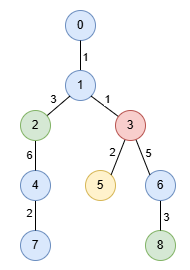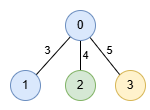LeetCode in Kotlin
3486. Longest Special Path II
Hard
You are given an undirected tree rooted at node 0, with n nodes numbered from 0 to n - 1. This is represented by a 2D array edges of length n - 1, where edges[i] = [ui, vi, lengthi] indicates an edge between nodes ui and vi with length lengthi. You are also given an integer array nums, where nums[i] represents the value at node i.
A special path is defined as a downward path from an ancestor node to a descendant node in which all node values are distinct, except for at most one value that may appear twice.
Return an array result of size 2, where result[0] is the length of the longest special path, and result[1] is the minimum number of nodes in all possible longest special paths.
Example 1:
Input: edges = [[0,1,1],[1,2,3],[1,3,1],[2,4,6],[4,7,2],[3,5,2],[3,6,5],[6,8,3]], nums = [1,1,0,3,1,2,1,1,0]
Output: [9,3]
Explanation:
In the image below, nodes are colored by their corresponding values in nums.

The longest special paths are 1 -> 2 -> 4 and 1 -> 3 -> 6 -> 8, both having a length of 9. The minimum number of nodes across all longest special paths is 3.
Example 2:
Input: edges = [[1,0,3],[0,2,4],[0,3,5]], nums = [1,1,0,2]
Output: [5,2]
Explanation:

The longest path is 0 -> 3 consisting of 2 nodes with a length of 5.
Constraints:
2 <= n <= 5 * 104edges.length == n - 1edges[i].length == 30 <= ui, vi < n1 <= lengthi <= 103nums.length == n0 <= nums[i] <= 5 * 104- The input is generated such that
edgesrepresents a valid tree.
Solution
@Suppress("kotlin:S107")
class Solution {
fun longestSpecialPath(edges: Array<IntArray>, nums: IntArray): IntArray {
val ans = intArrayOf(0, 1)
val graph: MutableMap<Int, MutableList<IntArray>> = HashMap<Int, MutableList<IntArray>>()
for (edge in edges) {
val a = edge[0]
val b = edge[1]
val c = edge[2]
graph.computeIfAbsent(a) { _: Int -> ArrayList<IntArray>() }
.add(intArrayOf(b, c))
graph.computeIfAbsent(b) { _: Int -> ArrayList<IntArray>() }
.add(intArrayOf(a, c))
}
val costs: MutableList<Int> = ArrayList<Int>()
val last: MutableMap<Int, Int> = HashMap<Int, Int>()
dfs(0, 0, -1, ArrayList<Int>(mutableListOf<Int>(0, 0)), nums, graph, costs, last, ans)
return ans
}
private fun dfs(
node: Int,
currCost: Int,
prev: Int,
left: MutableList<Int>,
nums: IntArray,
graph: MutableMap<Int, MutableList<IntArray>>,
costs: MutableList<Int>,
last: MutableMap<Int, Int>,
ans: IntArray,
) {
val nodeColorIndexPrev: Int = last.getOrDefault(nums[node], -1)
last.put(nums[node], costs.size)
costs.add(currCost)
val diff = currCost - costs[left[0]]
val length = costs.size - left[0]
if (diff > ans[0] || (diff == ans[0] && length < ans[1])) {
ans[0] = diff
ans[1] = length
}
for (next in graph.getOrDefault(node, ArrayList<IntArray>())) {
val nextNode = next[0]
val nextCost = next[1]
if (nextNode == prev) {
continue
}
val nextLeft: MutableList<Int> = ArrayList<Int>(left)
if (last.containsKey(nums[nextNode])) {
nextLeft.add(last[nums[nextNode]]!! + 1)
}
nextLeft.sortWith(Comparator.naturalOrder<Int>())
while (nextLeft.size > 2) {
nextLeft.removeAt(0)
}
dfs(nextNode, currCost + nextCost, node, nextLeft, nums, graph, costs, last, ans)
}
last.put(nums[node], nodeColorIndexPrev)
costs.removeAt(costs.size - 1)
}
}

